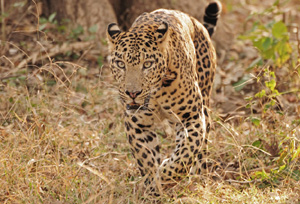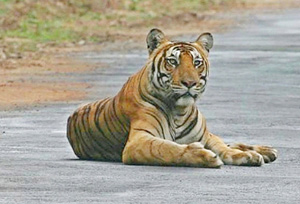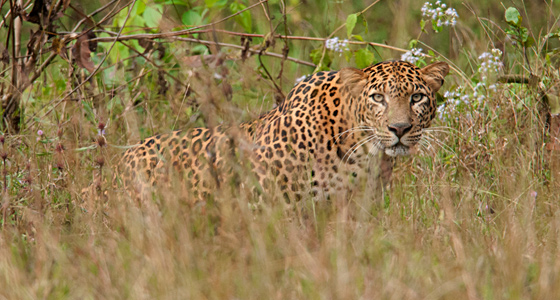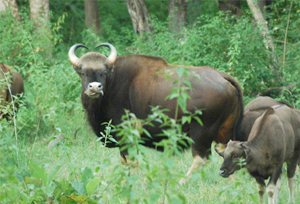Nagarhole National Park
 Nagarhole National Park, also known as Rajiv Gandhi National Park is the enchanting 247 square-mile long wild reserve located in Kodagu and Mysore district of Karnataka. Adorned with rich forest cover at the west of the Kabini River, the Nagarhole National Park is counted among the well maintained national parks in India.
Nagarhole National Park, also known as Rajiv Gandhi National Park is the enchanting 247 square-mile long wild reserve located in Kodagu and Mysore district of Karnataka. Adorned with rich forest cover at the west of the Kabini River, the Nagarhole National Park is counted among the well maintained national parks in India.
Nagarhole's summers (March-May) do not cross the temperature more than 33°C. Although, winters are brief to last from November to January, has got the temperature plummeting to 14°C. Monsoons are simply erratic, but it generally rains from June to September. By receiving the annual rainfall of 1,440 millimeters, the area of Nagarhole bring plush environment around the locality with the availability of great water resources like Lakshmmantirtha river, Sarati Hole, Nagar Hole, BalleHalla, Kabini River, four perennial streams, 47 seasonal streams, four small perennial lakes, 41 artificial tanks, several swamps, Taraka Dam and the Kabini reservoir. 
Flora The predominant vegetation in the Nagarhole National Park is of southern tropical, moist, mixed deciduous type with a substantial eastern portion intergrading into dry deciduous type. The upper tree canpy is dominated by Terminaliatomentosa is association with Tectoniagrandis, Dalbergialatifolia, Pterocarpusmarsupium, Lagerstroemia lanceolata, Anogeissuslatifolia, Adina cordifolia, Boambaxmalabaricum, Schleicheratrijuga, Ficus sp. and others. The lower canopy has Kydiacalycina, Emblicaofficinalis, Gmelinaarborea etc. Several shrubs belonging to Solanum, Desmodium and Helicteres sp. etc. are abundantly found but weedy shrubs like Eupatorium and Lantana now dominate.
History
Nagarhole name has been derived from two Kannada name, Nagar means "snake" and hole meaning streams. Genuinely, the name strikes the true meaning to this national park where few serpentine streams fork through the rich tropical forests running eastwards through its center. The birth of Nagarhole National Parkcan be traced by the stretching area of 258 sq km when it was a hunting reserve for the Maharajas of Mysore. That time it included some of the areas of the forest like Arkeri, Hatgat and Nalkeriin Kodagu. Subsequently in the year 1974 some other reserve forests from the adjoining areas of Mysore district were added to bring the area as Nagarhole Game Reserve and then was updated into the national park extending by the area 643.39 sq km in the year 1988.
The park was declared as a tiger reserve in the year 1999 to exemplify rich forest cover, small streams, hills, valleys and waterfalls. The park has a healthy tiger-predator ratio, with many tigers, Indian bison and elephants.
Wildlife
Nagarhole is flourished with important predators and carnivorous to bring the most wildering effects on the wildlife lovers where they can witness tremendous counts of tiger, leopard, wild dog (dhole or Cuonalpinus), sloth bear and the hyena (Hyaenahyaena). Even the girded area is also adhered with many herbivores like spotted deer, sambar, barking deer, four-horned antelope (Tetracerusquadricornis), gaur (Bosgaurus), wild boar (Susscrofa) and elephant. Nagarhole National Park provides an opportunity to see some of the southern population of Gaur (jungle Bison). Also, this park in Karnataka is a good place to see elephants in the luxuriant forests and bamboo thickets which they most enjoy. Their total population in southern India is now about 6500, nearly all living in the area where Karnataka, Tamil Nadu and Kerala adjoin in the shadow of the Western Ghats. Other mammalian miscellany includes the, Bonnet macaque (Macacaradiata), jungle cat, slender Loris (Loris tadigradus), common langur (Presbytes entellus), civet cat (Viverriculaindica, leopard-cat (Felisbengalensis) and Paradoxurushermaphroditus), mongoose (Herpestesfuscus and Herpestesvitticollis), common otter (Lutralutra), giant flying squirrel (Petauristapetaurista), giant squirrel (Ratufaindica), porcupine, jackal, mouse-deer (Tragulusmeminna), hare and pangolin (Maniscrassicaudata). Over 250 species of avians can also be traced in the Nagarhole vicinity wherethe enormous variety of woodland birds can be explicitly found. Besides, there are large congregations of water fowl in the KabiniRiver along with other ranges of Nagarhole birds from blue-bearded bee-eater, scarlet minivet and Malabar whistling thrush to the more common ospreys, herons and ducks.
The most commonly found reptiles are the marsh crocodile, monitor lizard, rock python and several other species can be represented in the area. Aquatic and terrestrial tortoises, frogs, toads and tree frogs and myriad insects, including some very colorful butterflies, adorn this lovely southern jungle of India.
Flora
The vegetation is comprised mainly of North Western Ghats, moist deciduous forests with (teak and rosewood predominating in the southern parts. The presence of Central Deccan Plateau, dry deciduous forests with Pala indigo and thorny wattle towards the east bring the topography more ardent for lushly foliages. There are some additional sub-montane valleys, swamp forests with several species of the Eugenia genus.
The main trees found here are the commercially important rosewood, teak, sandalwood and silver oak. Species of trees of the dry deciduous forest include crocodile bark, Lagerstroemia lanceolata (Crepe myrtle),Grewiatilaefolia, Indian Kino Tree, rosewood and axlewood. Other tree species that are seen in the forests are Lagerstroemia microcarpa (Crepe myrtle), Schleicheratrijuga, Kadam, cotton tree and some species of Ficus.
Along with that some other species may also be found germinating at Nagarholeto include Kydiacalycina, Indian gooseberry and Beachwood, Shrubs like horse nettles, tick clover, Helicteres species and invasive species like lantana and bonesets are found in abundance.
Forests of the reserve area may also have some conspicuous tree species such as golden shower tree, Flame of the Forest and clumping bamboo for more wildernesses.
Places of Interest
Kutta : Presiding not so far way from Nagarhole National Park, the place is named after Kutta, the son of Goddess Kali. It is believed that Goddess Kali came to this place and resided here with low-caste Kurubas. It is here that she had a son named Kutta. A major festival celebrated here to honor the goddess that can be witnessed on the occasion.
Irppu Falls : Yet another crowd puller near Nagarhole National Park, this spot is extremely scenic. As the water gushes down Brahmagiri, a fall is formed at this spot which is termed as Irppu Falls.
Ishwara Temple : This is an important pilgrim and tourist center near Nagarhole, where legends trails that a Shivalinga was placed by Lord Rama himself. The temple is flocked by devotees in the mornings and is closed during the afternoon.
Nearby Places
Nagarhole is the place which is located at the most juncture of all the rest of the national parksin the area. So let's find some other national parks and sanctuaries around Nagarhole National Park
 Bandipur National Park : Famous for its tigers, Bandipur National Park hosts a variety of exotic flora and fauna. It is one of the protected areas within Nilgiri Biosphere Reserve, located 123 kms from Nagarhole to hardly carry for next two hours to reach the place.
Bandipur National Park : Famous for its tigers, Bandipur National Park hosts a variety of exotic flora and fauna. It is one of the protected areas within Nilgiri Biosphere Reserve, located 123 kms from Nagarhole to hardly carry for next two hours to reach the place.
Wayanad National Park : Simply 52 kms away from Nagarhole wildlife area, this is the second largest wildlife sanctuary in Kerala. Wayanad Wildlife sanctuary hosts a rich collection of endangered wildlife species which is also home to large herds of elephants. The national park also comes under Project Elephant.
Ranganathittu Bird Sanctuary : Situated 80 km from the park, Ranganathittu Bird Sanctuary is a small sanctuary hosting some of the best avian species such as wooly necked stork, common spoonbill, Asian open bill stork and more, apart from some floral and mammal species too.
Bramhagiri Wildlife Sanctuary : This is a popular wildlife sanctuary separated from Nagarhole National Park by Kabini River. It hosts a great variety of flora and fauna. Animals like jungle cat, sloth bear, tiger, elephant, gaur, etc. can be spotted in the park.
Mudumalai National Park : The Madumalai National Park is most famous for its elephant population. It also boasts a good number of tiger populations and has been declared a tiger reserve. Panther, sambar, spotted deer, blackbuck, common langur, etc. are other wildlife species that can be spotted in the park. Interestingly, 13% of all mammal species in India are found in Mudumalai National Park.
Kabini Lake is another prime attraction situated 13 km outside the national park where the tourists can have the refreshing walk and some lucrative moments.
Safaris
Nagarhole is the place where the safari experience can be felt with great surprises. With the presence of abundance of wildlife, this place brings tremendous crowd of wildlife lovers for sighting of elephants, sambhar, spotted deer, gaur, wild boar, sloth bear, wild dogs, etc. which is quite assured. And if anyone is very lucky for sure, he/she can also have a fascinating encounter with a tiger or a panther too. The tourists are really permitted to shoot; yes they are, but not with the guns, with their cameras and videos and that truly bring a rewarding experience.
Vehicle Safari:
During the boat safari, you can see many large and small herbivores such as Asiatic Elephant. Further, you can also get a chance to spot the predators like the Leopardare and Tiger.
Timing:
Morning Safari: Between 05:30 AM to 10:00 AM
Evening Safari: Between 03:00 PM to 07:00 PM
Boat Safari:
While enjoying the boat safari, you will go upstream on the River Kabini from the resort and arrive at the area which divides the Bandipur and Nagarhole National Parks. Apart from witnessing many animals on the shore of the river, you can also witness the Marsh Crocodile and many other water birds.
Timing:
Morning Safari: Between 06:30 AM to 09:15 AM
Evening Safari: Between 03:30 PM to 06:15 PM
Coracle ride (On River Kabini)
Coracle is a traditional round shaped boat designed to take ride on Indian Rivers. You can ride on a Coracle and slowly drift down the Kabini River while holding close to the shoreline. During this adventures journey, you will have an incredible experience of connecting with the river indirectly. With many slow drifts, you will come to know about many interesting facts about the river.
Timing
Morning Safari: Between 09 AM to 11 AM
Evening Safari: Between 05 PM to 06:00 PM
Travel Information
Nagarhole National park is well connected to the adjoining areas of Karnataka. The motorable highways are linked to the park to the towns of Madikere (90 km) and Mysore (96 km). The journey from both places will stretch the timingsup to 2 hours. Similarly, the nearest well-connected railway junction is Mysore, while the nearest international airport is Bangalore (220 km). Advantageously, various airlines also connect Bangalore to the rest of the nation.
The best time to view the animals is during the heat of April& May, when the waterholes are dry and the animals come out and visit the lake. However, the weather is more pleasant from November to February.
Travel Tips
One must arrive at the park gates well before dusk, for the road through the park that leads to the lodges is prone to elephant blocks and closes at 6 pm. Those interested in trekking should avoid visiting the park during monsoons as floods wash out most of its dirt tracks and leeches render trekking impossible.
Hotels
The Nagarhole Tiger Reserve area is extenuated with great residing options in the area so as to make the jungle tour more adventurous and thrilling with the advancements of comfy services. One can stay in the Nagarhole Forest Guest house with prior booking from Wildlife department in Mysore. Besides, number of private lodges and guest houses are available at Kutta, the area available just at the outskirt of the park on the way to Irrupu Falls. Murkal is also the most demanding place in the Nagarhole vicinity to get a number of private lodges and resorts.









 Nagarhole National Park, also known as Rajiv Gandhi National Park is the enchanting 247 square-mile long wild reserve located in Kodagu and Mysore district of Karnataka. Adorned with rich forest cover at the west of the Kabini River, the Nagarhole National Park is counted among the well maintained national parks in India.
Nagarhole National Park, also known as Rajiv Gandhi National Park is the enchanting 247 square-mile long wild reserve located in Kodagu and Mysore district of Karnataka. Adorned with rich forest cover at the west of the Kabini River, the Nagarhole National Park is counted among the well maintained national parks in India. 



 Bandipur National Park : Famous for its tigers, Bandipur National Park hosts a variety of exotic flora and fauna. It is one of the protected areas within Nilgiri Biosphere Reserve, located 123 kms from Nagarhole to hardly carry for next two hours to reach the place.
Bandipur National Park : Famous for its tigers, Bandipur National Park hosts a variety of exotic flora and fauna. It is one of the protected areas within Nilgiri Biosphere Reserve, located 123 kms from Nagarhole to hardly carry for next two hours to reach the place. 